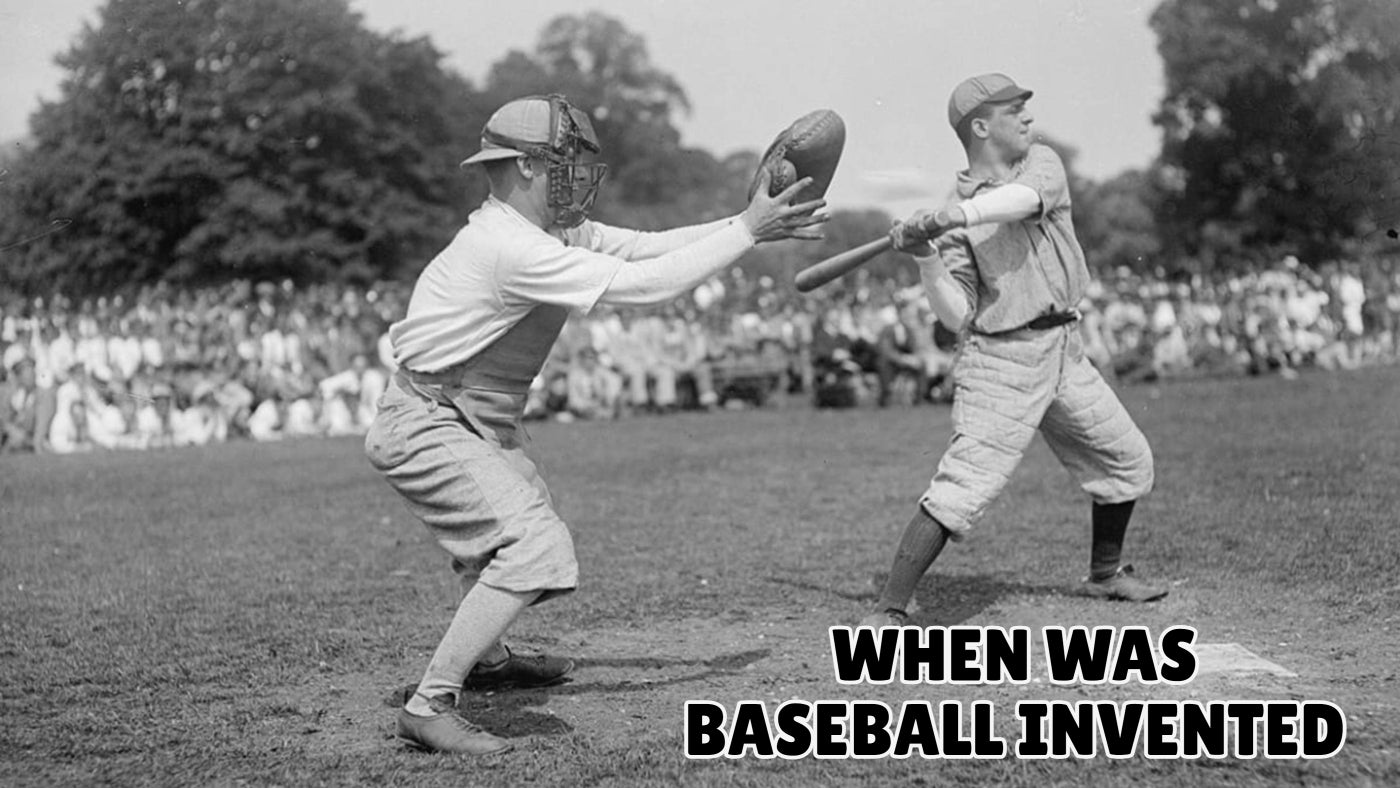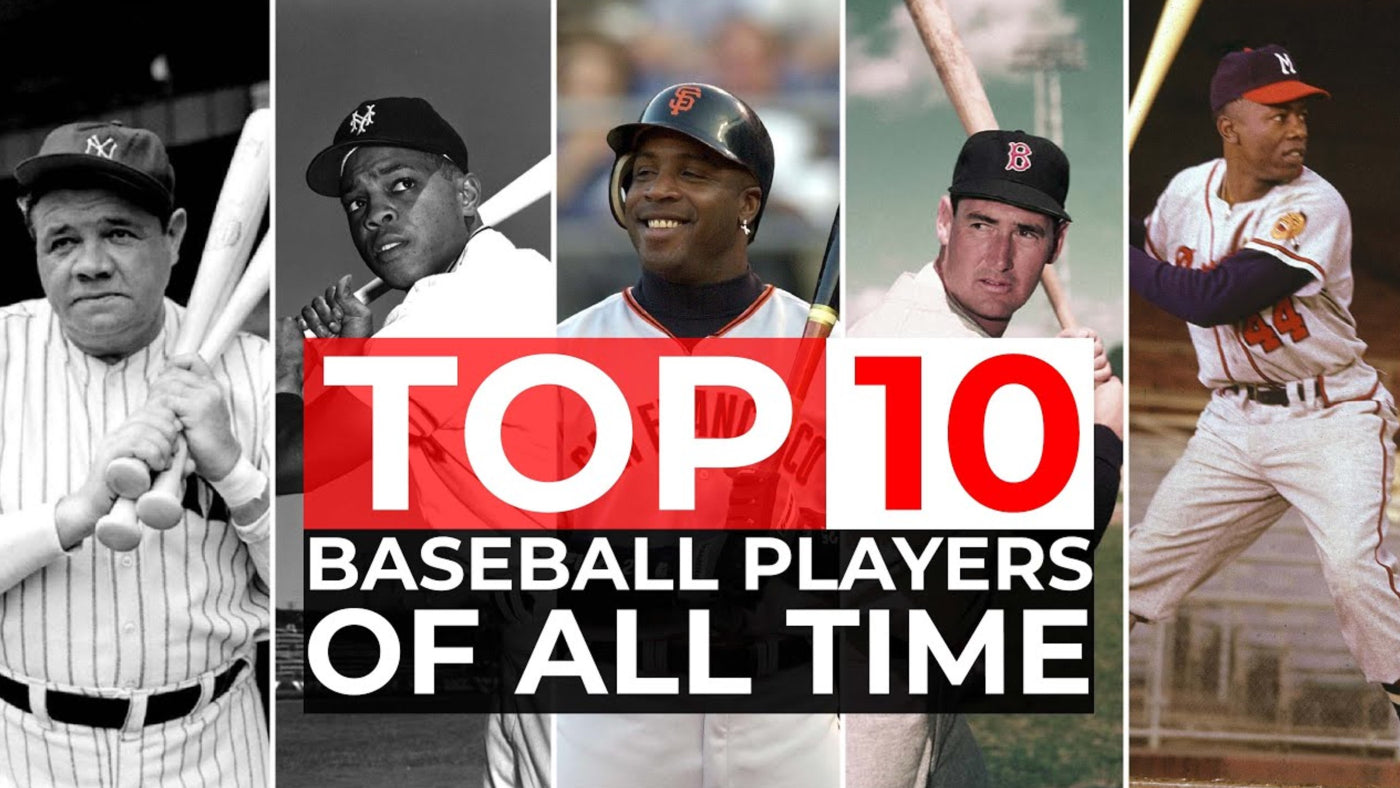Your Cart is Empty
- Blanket 🔥
- Valentine ❤️
-
Recipients
-
Pet
-
Memorial
-
Products
-
Home & Garden
-
Accessories
- Happy Customers ❤️
When Was Baseball Invented? History Of Basketball
July 17, 2023 10 min read

Baseball has long been hailed as America's favorite pastime, captivating millions of fans with its rich history and thrilling gameplay. But when exactly was baseball invented? Delving into the origins of this beloved sport reveals a fascinating journey that spans centuries. In this article, we'll explore the evolution of baseball, from its early influences to the modern game we know today.
Contents

"The construction of a modern baseball"
1. Early Origins and Influences of Baseball
Baseball's roots can be traced back to ancient civilizations that engaged in various bat-and-ball games. Although these early forms of the game differed in rules and structure, they laid the groundwork for the sport we now cherish. Notably, rounders, a game played in England since the 18th century, played a significant role in shaping modern baseball. Rounders featured elements such as hitting a ball with a bat and running around bases, akin to the core mechanics of baseball.
Baseball is a sport with a rich history that evolved over time, drawing influences from various games and pastimes. While its exact origins are still a topic of debate, there are several early games and influences that played a role in the development of baseball. Here are some of the key factors:
- English Bat-and-Ball Games: Baseball's roots can be traced back to old English bat-and-ball games like rounders and cricket. Rounders, in particular, was a popular game in England that involved hitting a ball with a bat and running around bases.
- Town Ball: Town ball, a game played in North America during the 18th century, is often cited as an early precursor to baseball. It featured a diamond-shaped field, bases, and pitching to a batter.
- Massachusetts Game: The Massachusetts Game, also known as the Massachusetts Rules, was a variation of town ball that was played in the mid-19th century. It incorporated elements like a diamond-shaped field, a four-base layout, and the concept of innings.
- Alexander Cartwright: Alexander Cartwright, a founding member of the New York Knickerbocker Base Ball Club, is often credited with formalizing the rules of baseball in the 1840s. Cartwright's Knickerbocker Rules introduced several key aspects of the game, including the nine-player team, the diamond-shaped infield, and the three-strike rule.
- The New York Game: The New York Game, influenced by the Knickerbocker Rules, became a popular form of baseball in the mid-19th century. It spread throughout the Northeastern United States and laid the foundation for the modern game.
- Civil War Influence: Baseball gained significant popularity during the American Civil War, as soldiers played the game during their leisure time. This contributed to its spread across the country and the establishment of regional leagues after the war.
- Professionalization and Major League Baseball: In 1871, the first professional baseball league, the National Association of Professional Base Ball Players, was formed. It was followed by the establishment of the National League in 1876, which eventually became Major League Baseball (MLB).
These early influences and developments set the stage for the growth and evolution of baseball as we know it today. The sport continued to evolve with the introduction of new rules, the establishment of additional leagues, and the integration of African American players, culminating in baseball becoming one of the most popular sports in the United States and gaining international recognition.
2. The Development of Modern Baseball
In the mid-19th century, Alexander Cartwright and his Knickerbocker Base Ball Club in New York City played a pivotal role in formalizing the rules of baseball. In 1845, the club established a set of guidelines, often referred to as the "Knickerbocker Rules." These rules standardized the game, defining aspects such as base distances, the number of players on each team, and the concept of outs. The adoption of these rules by other clubs led to the spread and popularization of baseball.
The development of modern baseball can be traced through several key milestones and changes that have shaped the sport into what it is today. Here are some of the significant developments:
- Knickerbocker Rules: As mentioned earlier, Alexander Cartwright and the New York Knickerbocker Base Ball Club introduced the Knickerbocker Rules in the mid-19th century. These rules standardized the game and formed the basis for many of the fundamental elements of baseball, including the nine-player team, the diamond-shaped infield, and the three-strike rule.
- National League and American League: The late 19th century saw the establishment of professional baseball leagues. The National League was formed in 1876, followed by the American League in 1901. These leagues competed independently until they merged in 1903, creating Major League Baseball (MLB) as we know it today.
- The Rise of Babe Ruth: In the early 20th century, Babe Ruth emerged as one of baseball's most iconic figures. Ruth's exceptional hitting prowess and record-breaking home run totals revolutionized the game and ushered in the "live-ball era." His popularity and success helped baseball gain widespread attention and turned it into America's national pastime.
- Integration of Baseball: For much of its early history, professional baseball was segregated, with African American players excluded from the major leagues. However, in 1947, Jackie Robinson broke the color barrier when he debuted for the Brooklyn Dodgers. This historic event marked a significant step toward racial integration in professional sports and had a profound impact on the civil rights movement.
- Expansion and Franchise Movement: Over the years, MLB has undergone significant expansion and franchise movement. From the original eight teams, the league expanded to 30 teams with the addition of various franchises through expansion and relocation. This growth has helped baseball become a more geographically diverse and inclusive sport.
- Evolution of the Game: Baseball has evolved in terms of strategy, player development, and technology. Innovations such as the introduction of relief pitchers, specialized defensive positions, statistical analysis (sabermetrics), and advancements in equipment have all had a profound impact on the game's development and the way it is played.
- Internationalization: While baseball has primarily been associated with North America, it has gained popularity internationally. Major League Baseball has actively promoted the sport globally, leading to the establishment of professional leagues in countries like Japan (Nippon Professional Baseball) and South Korea (Korea Baseball Organization), as well as the participation of players from various countries in MLB.
These developments have shaped modern baseball into a widely followed and globally recognized sport. The game continues to evolve with rule changes, advancements in technology, and ongoing efforts to make the sport more inclusive and engaging for fans worldwide.
3. Spread of Baseball in the United States
The spread of baseball across the United States was a remarkable phenomenon that transformed it into America's beloved national pastime. The game's popularity surged as it made its way from regional pockets to becoming a staple in communities across the country. The spread of baseball was fueled by various factors, including the formation of professional leagues, the influence of amateur clubs, and the sport's cultural significance.
In the mid-19th century, regional leagues and amateur clubs played a pivotal role in introducing baseball to different parts of the United States. These grassroots efforts provided platforms for organized play and competition, capturing the attention of local communities. As the game gained traction, it quickly became a source of entertainment and camaraderie.
The American Civil War also played a significant role in spreading baseball. Soldiers played the game during their leisure time, bringing it to new areas and instilling a love for the sport in the hearts of many. After the war, these veterans brought their passion for baseball back to their hometowns, further fueling its expansion.
The establishment of professional leagues, starting with the formation of the National League in 1876, accelerated the spread of baseball. Professional teams provided a higher level of competition and drew larger audiences. The growth of professional baseball coincided with the development of transportation networks, allowing teams to embark on barnstorming tours and showcase the sport to fans across the nation.
Baseball's cultural impact cannot be understated. It became more than just a game; it embodied the American spirit and values. The sport fostered a sense of community pride and regional identity. Baseball became an integral part of American culture, captivating fans and becoming a source of joy and unity.
Advancements in technology, such as radio broadcasts and later television coverage, played a crucial role in spreading baseball to wider audiences. Fans from all corners of the country could follow their favorite teams and players, forging deep connections with the sport.
Through the efforts of amateur clubs, professional leagues, cultural significance, and technological advancements, baseball spread throughout the United States, transcending geographic boundaries and becoming ingrained in the fabric of American society. Today, baseball remains an enduring symbol of unity and an integral part of the nation's sporting landscape.
4.Baseball's Evolution in the 20th Century

"Baseball has changed drastically since 1908”
The 20th century witnessed significant evolution and transformative changes in the game of baseball. This period saw the sport grow in popularity, adapt to new challenges and opportunities, and undergo various rule changes and technological advancements. Here is a glimpse into baseball's evolution in the 20th century:
- The Rise of Power Hitting: The early 1900s marked a shift towards a more aggressive and power-oriented style of play. Players like Babe Ruth, known as the "Sultan of Swat," revolutionized the game with their exceptional hitting skills and home run prowess. This era, known as the "live-ball era," saw an increase in offensive output and a greater emphasis on power hitting.
- Expansion and Franchise Movement: Baseball experienced significant expansion in the 20th century. New teams were added to the Major League Baseball (MLB), extending the sport's reach across the United States. Additionally, there were instances of franchise movement as teams relocated to new cities, reflecting the changing demographics and preferences of fans.
- Integration of Baseball: One of the most important milestones in baseball's history occurred in 1947 when Jackie Robinson broke the color barrier, becoming the first African American player in the modern era of MLB. Robinson's entry into the league paved the way for the integration of baseball and served as a catalyst for the civil rights movement.
- Rule Changes and Innovations: Baseball underwent several rule changes throughout the 20th century to adapt to the evolving nature of the game. Notable changes included the introduction of the designated hitter (DH) in the American League in 1973, expanded playoffs with the introduction of the divisional series in 1969, and the use of instant replay for reviewing umpire decisions in recent years.
- Advancements in Technology: The 20th century brought about significant technological advancements that impacted the game of baseball. The introduction of radio broadcasts allowed fans to follow games from the comfort of their homes, while television coverage provided a visual experience of the sport. Later, innovations such as radar guns for measuring pitch speed, advanced statistics (sabermetrics), and video replay systems further enhanced the understanding and analysis of the game.
- Globalization and International Competitions: Baseball's popularity expanded beyond the borders of the United States in the 20th century. The sport gained international recognition, leading to the establishment of various professional leagues and international competitions. The World Baseball Classic, inaugurated in 2006, became a significant event that showcased the talent and passion for baseball worldwide.
- Changing Business Landscape: Baseball evolved as a business in the 20th century, with the sport becoming more commercially driven. Stadiums grew larger and more modern, and revenue streams diversified through broadcasting deals, merchandising, and sponsorships. The financial aspects of the game underwent substantial transformations, making baseball a major industry with a significant economic impact.
The 20th century was a transformative period for baseball, marked by shifts in playing styles, integration, rule changes, technological advancements, globalization, and changes in the business landscape. These developments contributed to baseball's enduring popularity and its status as a cherished part of American culture and beyond.
5. Baseball's Global Influence
Baseball's influence extends well beyond the borders of the United States, as the sport has gained significant global popularity and has become a means of cultural exchange. Baseball's global influence can be seen through its spread to different countries, the establishment of professional leagues worldwide, and the participation of international players in Major League Baseball (MLB).
The sport's global reach can be traced back to the late 19th and early 20th centuries when baseball began to spread to other countries through various channels. American soldiers stationed abroad during World War I and II played baseball, introducing the game to local communities. As a result, baseball gained traction in countries like Japan, Cuba, and the Dominican Republic.
Japan stands out as a nation deeply influenced by baseball. Introduced to the country in the late 19th century, baseball became immensely popular, with professional leagues like Nippon Professional Baseball (NPB) forming in the 1930s. Japanese players have also made their mark in Major League Baseball, with stars like Ichiro Suzuki and Shohei Ohtani showcasing their exceptional skills on the international stage.
Latin American countries have also embraced baseball as a major sport. The Dominican Republic, Venezuela, and Cuba have produced numerous talented players who have excelled in the major leagues. Baseball has become an integral part of their national identities, and their passion for the sport is evident in the strong baseball culture and the success of their players at the highest level.
In recent years, baseball's global influence has expanded even further. Professional leagues have been established in various countries, including South Korea (Korea Baseball Organization - KBO), Taiwan (Chinese Professional Baseball League - CPBL), and Australia (Australian Baseball League - ABL). These leagues provide opportunities for local talent to showcase their skills and contribute to the growth of baseball worldwide.
The international appeal of baseball is also evident in events like the World Baseball Classic, where national teams from different countries compete for global supremacy. This tournament brings together the best players from around the world and allows fans to celebrate the sport's diversity and talent on a grand stage.
Baseball's global influence is not limited to the professional level. The sport is played at amateur and youth levels in many countries, fostering camaraderie, cultural exchange, and a shared love for the game. Baseball transcends language barriers and serves as a bridge between different cultures, promoting understanding and friendship.
Baseball's global influence continues to grow, with more countries embracing the sport and producing top-tier players. The sport's ability to unite people from diverse backgrounds and create connections across borders underscores its enduring appeal and impact on the global stage.
6. Conclusion
The invention of baseball may not have a singular date attributed to it, but its evolution over time is a testament to its enduring appeal. From ancient bat-and-ball games to the establishment of formal rules by Alexander Cartwright and the subsequent growth of the sport in the United States, baseball has woven itself into the fabric of American culture. Its journey continues to unfold, with new generations of players and fans ensuring its legacy lives on. As we reflect on the rich history of baseball, we can't help but marvel at the profound impact this sport has had on our lives and society as a whole.
Related products for Baseball Lovers:

Hazel Edison
Hazel Edison's mission as a content marketer and social media manager is to help businesses connect with their target audience through engaging and informative content. With a deep understanding of the power of digital media, Hazel is committed to helping the brand build its online presence and drive results.
Related articles in Baseball

What Is a Quality Start in Baseball? Understanding the Pitching Metric
August 27, 2023 7 min read
Read More


